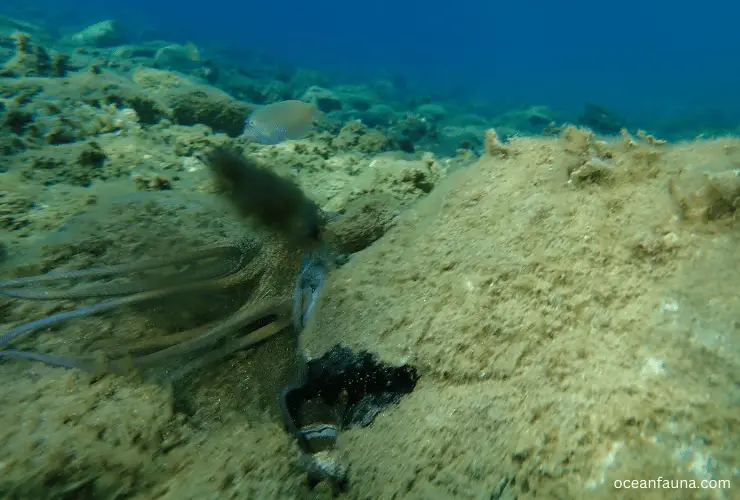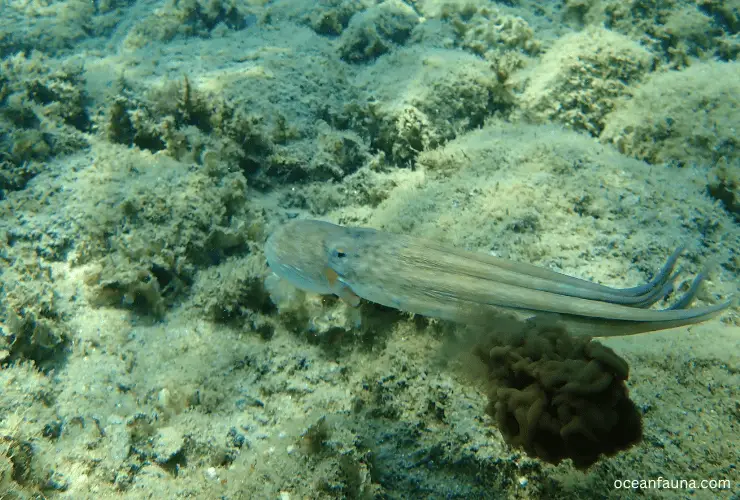No. Octopus ink, also known as cephalopod ink, is not poisonous. However, they have separate venom glands, which are not connected to the ink sacks.
If you want to know more about the ink of octopus, this article is for you.
What Is Octopus Ink?
Octopus ink, also referred to as Cephalopod ink, is a unique substance secreted by most species of octopuses as a defensive strategy against their predators. This ink is usually dark-colored or luminescent and released into the surrounding water by the cephalopods.
Octopuses use their ink primarily as a diversion tactic when they sense danger. When threatened, octopuses release a cloud of ink that temporarily obscures their predator’s vision, allowing the cephalopod to quickly swim away and escape from danger.
The composition of octopus ink is complex and consists of various organic compounds, including melanin, mucins, enzymes, and amino acids. Most notably, the melanin present in octopus ink is responsible for its dark coloration and helps to protect the organism from UV radiation and oxidative damage.
Interestingly, not all octopuses produce the same type of ink. Some species release luminescent ink that glows in the dark and may be used to help deceive predators or attract prey. Additionally, the composition of octopus ink can change depending on the octopus’s diet, age, environment, and other factors.
Although octopus ink has long been known for its use as a defense mechanism, recent research has revealed potential commercial applications for this unique substance. For instance, researchers are exploring the use of octopus ink as a natural food coloring or a possible treatment for certain medical conditions. More details are discussed below.
Usages Of Octopus Ink

Octopus ink is a unique substance that serves a variety of purposes. In this section, the different usages of octopus ink will be examined in detail.
Defence Mechanism
One of the primary uses of octopus ink is as a self-defense mechanism. When octopuses feel threatened by predators, they eject ink from their ink sacs to distract and confuse their attackers.
The ink is made up of melanin and mucus, creating a dark cloud the predator can’t see through. This allows the octopus to escape while the predator is disoriented.
Potential Medical Benefits
Research suggests that cephalopod ink may have potential medical benefits for humans. Melanin, an ink component, has been shown to have anti-cancer properties.
In fact, some studies have even shown that melanin from cephalopods could be used in anti-cancer drugs and chemotherapy. Additionally, compounds found in the ink can help protect immune cells, which may boost our immune response.
Pigment/Dye
Octopus ink is also used as a pigment and a dye. The ink has a deep black color, making it a popular choice for artists and designers. In addition to being used in traditional art forms, such as calligraphy and painting, octopus ink is also used as a dye for fabrics and other materials.
Writing Ink
In addition to being used as a pigment and dye, octopus ink is also used as writing ink. Historically, octopus ink was used as a writing ink in many cultures around the world. It was particularly popular in ancient China and Japan, where it was used for calligraphy and other forms of writing.
Food Coloring
Octopus ink is also used as a black food coloring or sauce. It’s commonly used in dishes like pasta, risotto, and squid ink paella. The ink provides a unique flavor and color to these dishes, making them highly sought after by foodies and chefs.
What Is the Chemical Compound of Octopus Ink?
Octopus ink is a fascinating and unique substance that has always intrigued scientists and researchers. It is a complex mixture of compounds produced by specialized cells located in the ink sac, a small gland found in the octopus body.
The ink is usually made up of secretions from two glands. The ink sac and its ink gland produce black ink that contains melanin. The majority of knowledge about cephalopod ink comes from the study of this ink. The funnel organ is a second organ that produces mucus but is not as well researched.

Although the chemical composition of octopus ink can vary slightly depending on the species and habitat of the octopus, most of the ink is made up of a mixture of melanins, proteins, polysaccharides, and other organic compounds.
The most abundant compound in octopus ink is melanin, which is responsible for its dark color and has been shown to possess antioxidant and antimicrobial properties.
Other important compounds found in octopus ink include tyrosinase. This copper-containing enzyme produces melanin from the amino acid tyrosine and peptides, which are protein fragments that have been shown to have various biological activities, including antimicrobial, antiviral, and anti-cancer properties.
Regarding the chemical formula of octopus ink, it is difficult to define a single compound, as it is composed of multiple compounds that vary in their chemical structure and properties. Nonetheless, studies have shown that octopus ink contains several amino acids, such as glycine, alanine, and leucine, and carbohydrates, including glucose and fructose.
Are Octopuses Venomous?
Yes, all octopuses are venomous. The venom in octopuses is typically used for self-defence, though some species also use it for hunting.
The venom is primarily comprised of neurotoxins, which affect the victim’s nervous system, leading to paralysis and potentially death. While octopuses are venomous, they are generally not aggressive toward humans and will only use their venom as a last resort.
However, it is still important to exercise caution when interacting with octopuses, particularly those with bright or iridescent coloring, such as the blue-ringed octopus, which is known to be particularly dangerous to humans.
Ingestion of the venom of a blue-ringed octopus can lead to death in as little as 30 minutes, making it one of the most venomous animals in the world and highlighting the importance of respecting these incredible creatures in their natural habitat.
Are Octopus Ink Sacks and Venom Glands Different?

Yes, an octopus’s ink sacks and venom glands are indeed different and are not linked in any way. While both can elicit a defensive response from predators, they serve different purposes within the octopus’s arsenal of defence mechanisms.
The ink sacks of an octopus are primarily used as a distraction to allow the creature to quickly escape from a potential predator. When threatened, the octopus releases a cloud of ink into the water, creating a dark, diaphanous cloud that temporarily obscures the predator’s vision and allows the octopus to quickly get away.
On the other hand, the venom gland of an octopus is used as a defensive weapon to deter predators and also to capture prey. The octopus’s venom contains a mix of toxins that can be lethal to smaller animals and cause severe pain and inflammation in larger predators or humans.
Is Octopus Ink Edible?
Yes, octopus ink is edible and is considered a delicacy in many parts of the world. Octopus ink is rich in flavor and has a unique taste that is often described as briny, smoky, or earthy. The ink is extracted from the octopus’s ink sac, a small gland located near the digestive system.
Octopus ink is used as a natural food coloring and is often added to dishes like pasta, risotto, and squid ink paella. The ink provides a deep black color to the dish, giving it a unique appearance highly sought by foodies and chefs. The ink also adds flavor to food, giving it a subtle yet distinctive taste.
The use of octopus ink as a food ingredient is not limited to just savory dishes. It can also be used to add color and flavor to desserts, such as ice cream and chocolate.
The ink has a high concentration of melanin, a natural pigment that is found in human skin. Melanin has been shown to have various health benefits, including antioxidant properties, anti-inflammatory effects, and even protection against UV radiation.
When preparing octopus ink for cooking, it is important to note that it can stain clothing and surfaces easily, so care should be taken when handling it. Additionally, the ink should be used in moderation, as it has a very strong flavor that can overpower other ingredients if used in excess.
Conclusion
Now you have a compact knowledge of the ink of an octopus. Octopus ink has many uses, from self-defence to cooking.
If you have further queries regarding this matter, just let me know. I will answer them as soon as possible.

